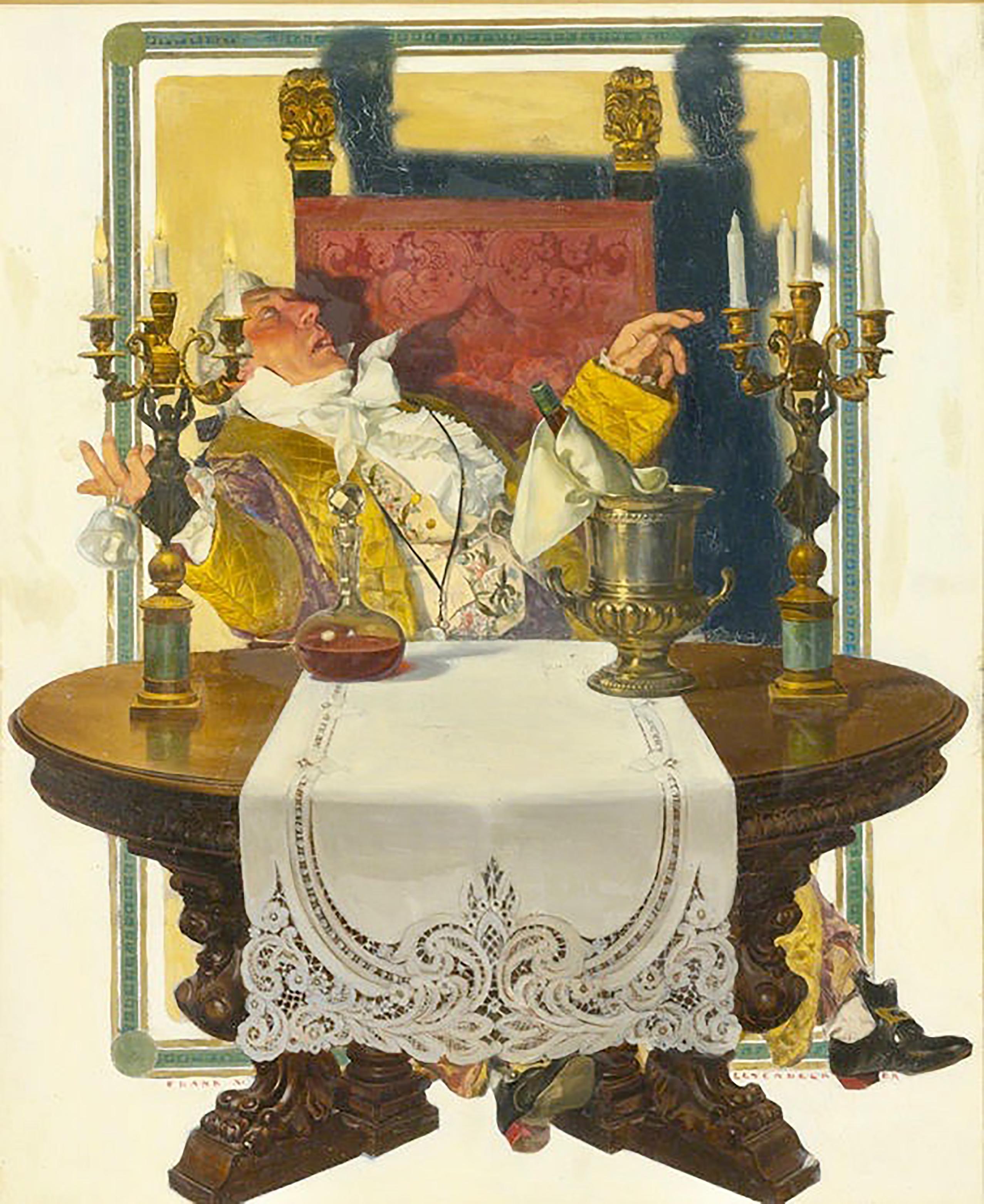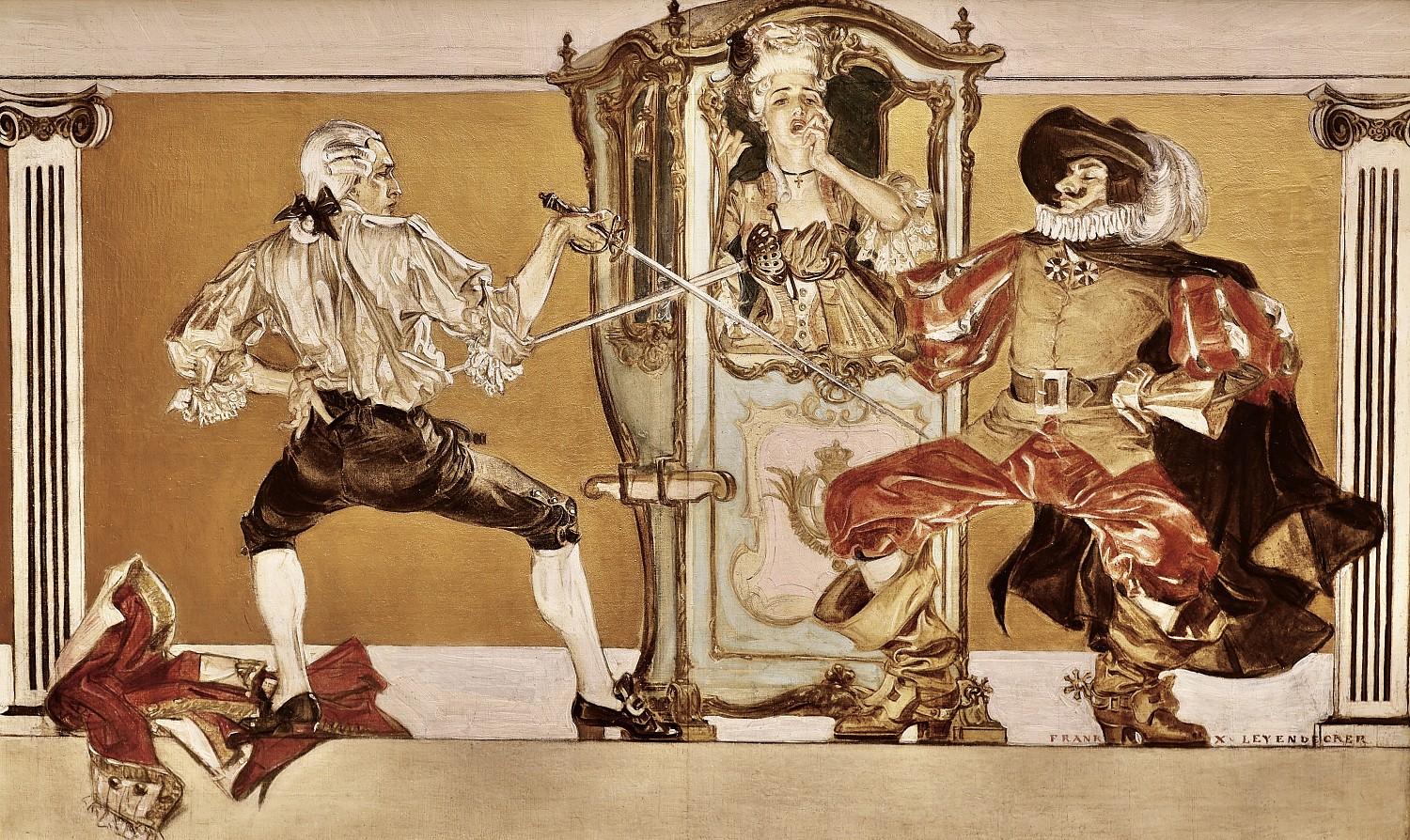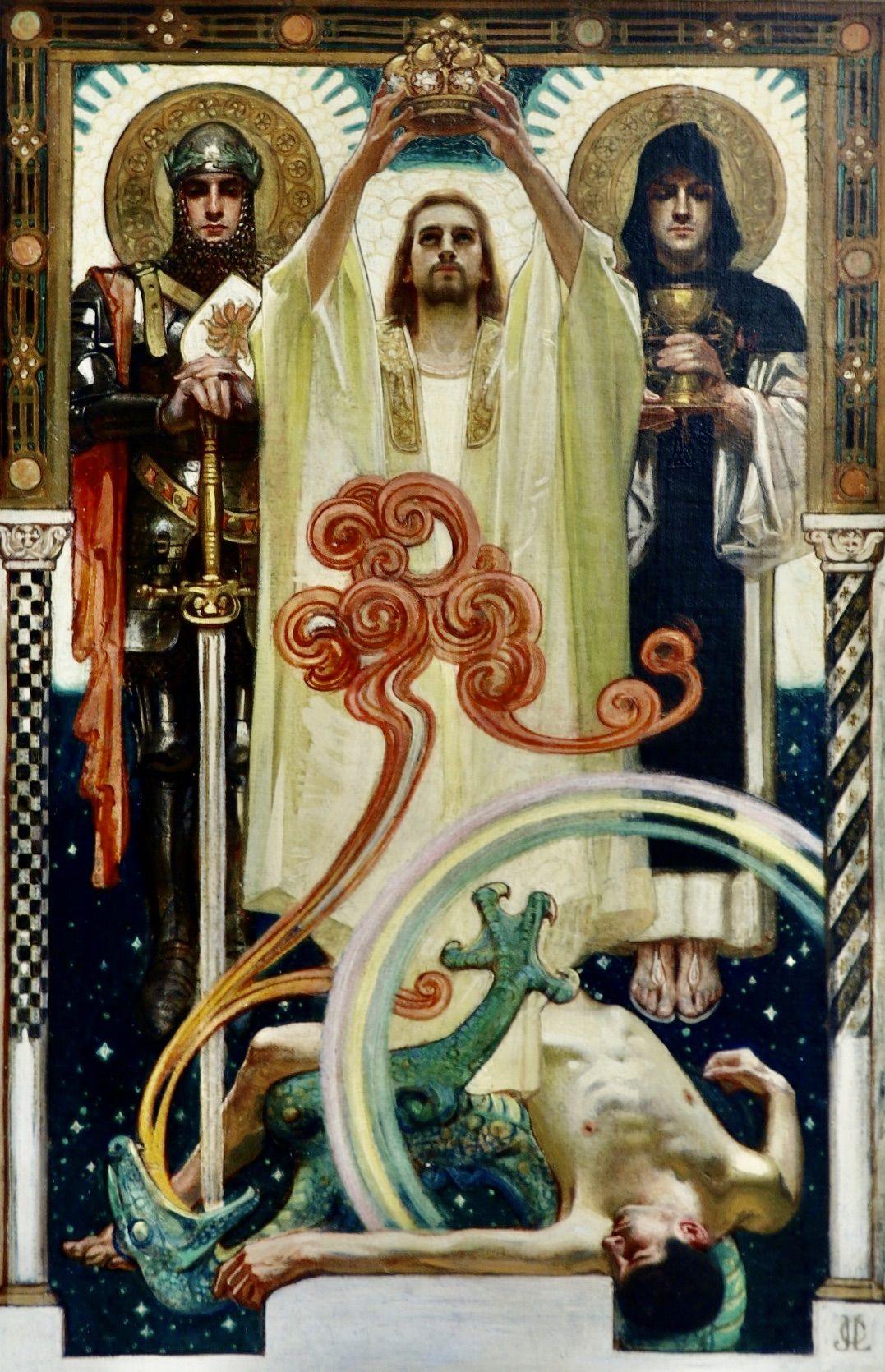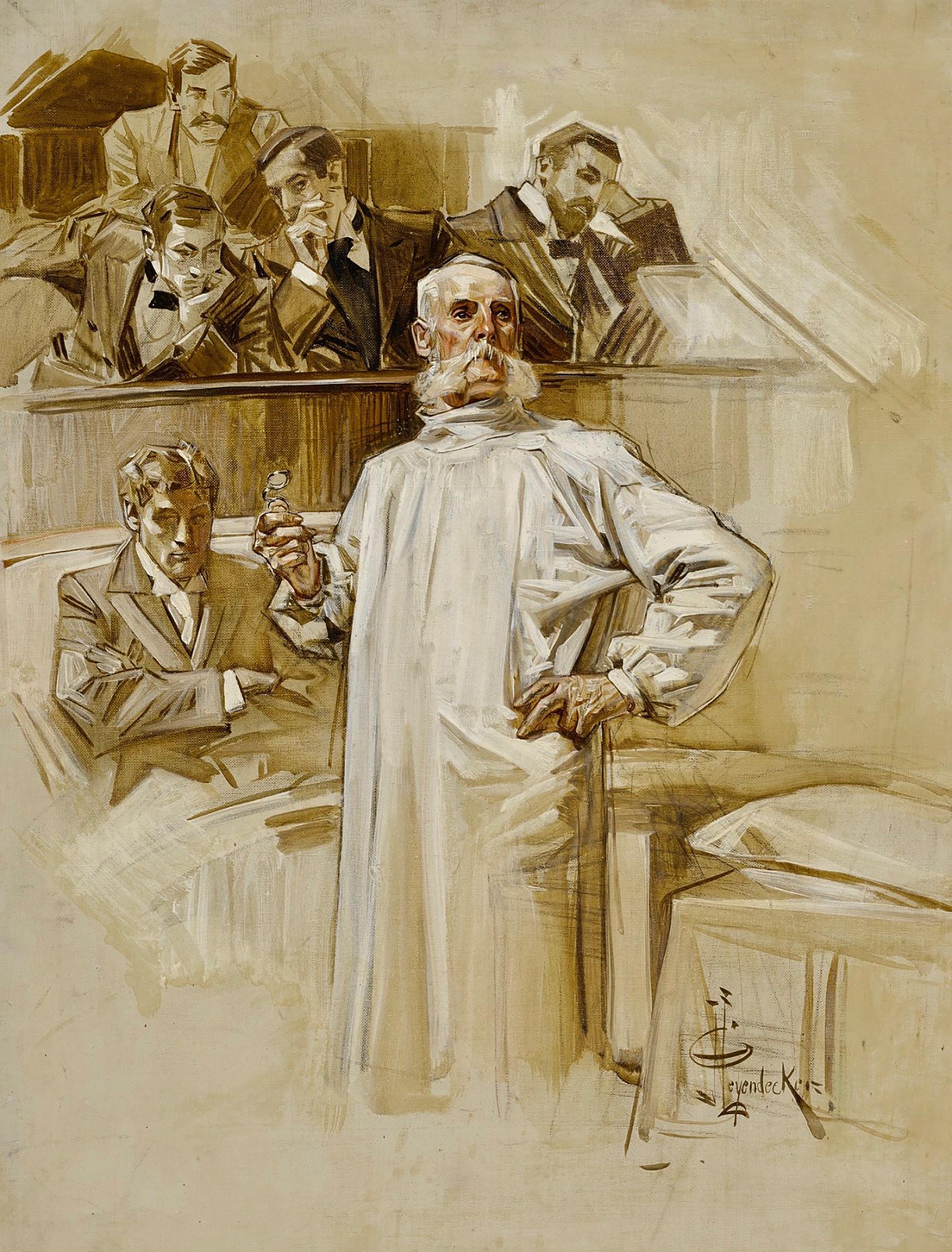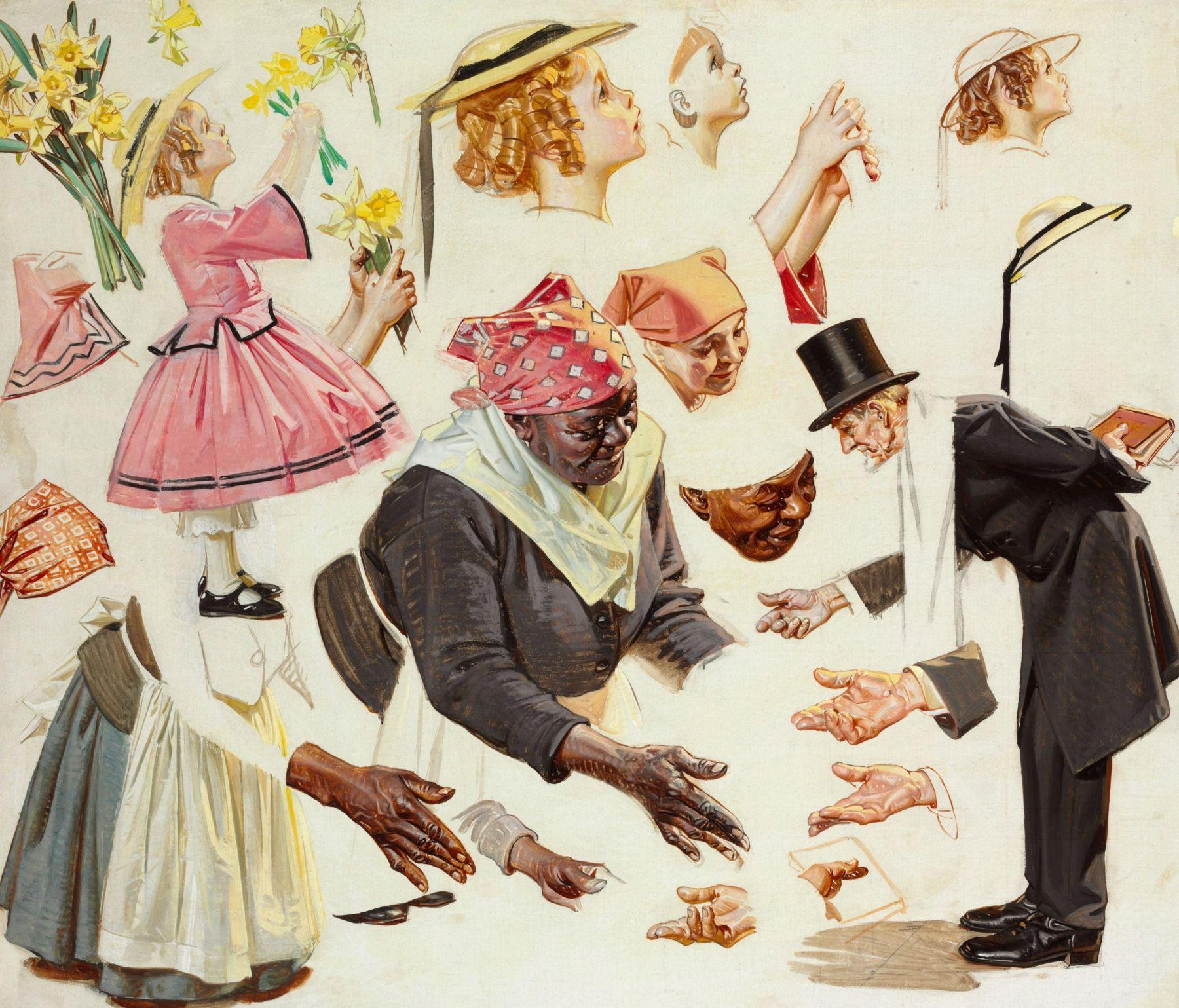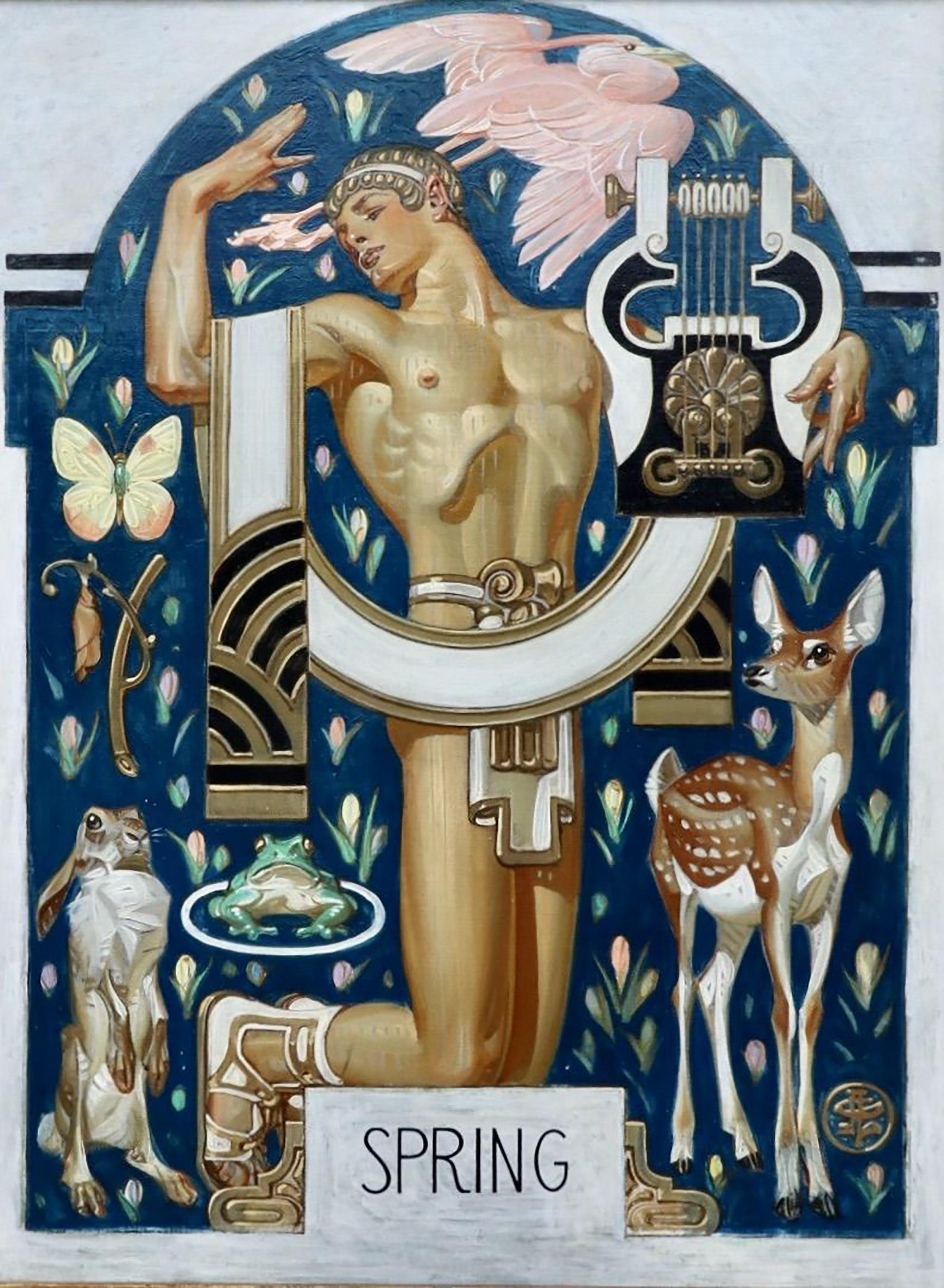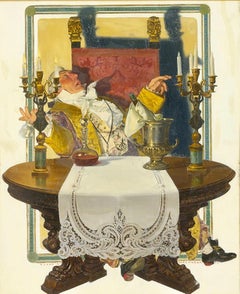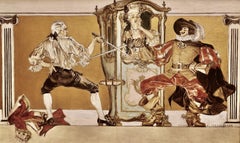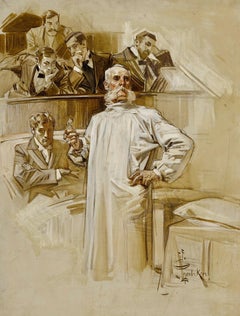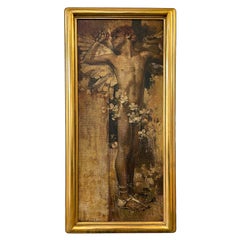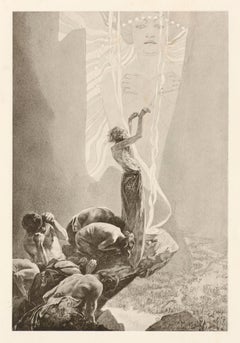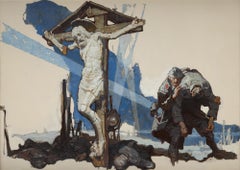Items Similar to The Abolishing of Death, Cosmopolitan commission, 1919
Want more images or videos?
Request additional images or videos from the seller
1 of 6
Frank Xavier LeyendeckerThe Abolishing of Death, Cosmopolitan commission, 19191919
1919
$29,000
£22,027.87
€25,383.57
CA$40,839.18
A$45,276.27
CHF 23,794.45
MX$554,107.32
NOK 297,168.46
SEK 278,922.33
DKK 189,472.62
About the Item
Signature: Signed Lower Right: F X Leyendecker
Medium: Oil on Board
Sight Size 18.75" x 24.75;" Framed 33.75" x 39.75"
RELATED LITERATURE:
B. King, "The Abolishing of Death," Cosmopolitan Magazine, New York, June-September, 1919, n.p.;
B. King, The Abolishing of Death, New York, 1919, n.p.
The present work was commissioned by Cosmopolitan Magazine for the serial "The Abolishing of Death" by Basil King. This specific Leyendecker illustration was not published within the magazine. However, the Cosmopolitan Book Corporation published the serial as a novel with illustrations by F. X. Leyendecker the same year, where the present work was possibly utilized.
- Creator:Frank Xavier Leyendecker (1877 - 1924, American)
- Creation Year:1919
- Dimensions:Height: 18.75 in (47.63 cm)Width: 24.75 in (62.87 cm)
- Medium:
- Period:
- Condition:
- Gallery Location:Fort Washington, PA
- Reference Number:Seller: 39311stDibs: LU38435712191
About the Seller
5.0
Recognized Seller
These prestigious sellers are industry leaders and represent the highest echelon for item quality and design.
Platinum Seller
Premium sellers with a 4.7+ rating and 24-hour response times
Established in 1995
1stDibs seller since 2016
134 sales on 1stDibs
Typical response time: 1 hour
- ShippingRetrieving quote...Shipping from: Fort Washington, PA
- Return Policy
Authenticity Guarantee
In the unlikely event there’s an issue with an item’s authenticity, contact us within 1 year for a full refund. DetailsMoney-Back Guarantee
If your item is not as described, is damaged in transit, or does not arrive, contact us within 7 days for a full refund. Details24-Hour Cancellation
You have a 24-hour grace period in which to reconsider your purchase, with no questions asked.Vetted Professional Sellers
Our world-class sellers must adhere to strict standards for service and quality, maintaining the integrity of our listings.Price-Match Guarantee
If you find that a seller listed the same item for a lower price elsewhere, we’ll match it.Trusted Global Delivery
Our best-in-class carrier network provides specialized shipping options worldwide, including custom delivery.More From This Seller
View AllThe Burgrave's Farewell
By Frank Xavier Leyendecker
Located in Fort Washington, PA
Medium: Oil Mounted to Board
Signature: Signed Lower Right
Sight Size 21.00" x 17.00;" Framed 26.00" x 22.00"
Titled The Burgrave's Farewell (along top under mat); Image size: 20 1/...
Category
Early 1900s Figurative Paintings
Materials
Oil, Board
The Duel, Cover for Kuppenheimer Style Book, Fall / Winter 1910-1911
By Frank Xavier Leyendecker
Located in Fort Washington, PA
Original Kuppenheimer Style Book Cover, Fall / Winter 1910-1911 edition
For the Fall/Winter 1910-1911 Kuppenheimer Style Book, Francis Xavier Leyendecker crafted a captivating cov...
Category
1910s Figurative Paintings
Materials
Oil, Canvas
“The Radiant Christ” for Delineator Magazine
By Joseph Christian Leyendecker
Located in Fort Washington, PA
Medium: Oil on Canvas
Signature: Signed Lower Right
Illustration for the poem “The Radiant Christ” by Ella Wheeler Wilcox for Delineator Magazine, published December 1907.
Ella Whe...
Category
Early 1900s Figurative Paintings
Materials
Canvas, Oil
"Mortmain" by Arthur Train, Book Illustration, 1918
By Joseph Christian Leyendecker
Located in Fort Washington, PA
Medium: Oil on Canvas
Signature: Signed Lower Right
Category
20th Century Figurative Paintings
Materials
Canvas, Oil
Study for 'Flowers for the President'
By Joseph Christian Leyendecker
Located in Fort Washington, PA
Medium: Oil on Canvas
Signature: Unsigned
Sight Size 23.50" x 27.25", Framed 29.50" x 33.00"
The present work is a study for Flowers for the President c...
Category
1930s Figurative Paintings
Materials
Canvas, Oil
Spring- Apollo and Animals
By Joseph Christian Leyendecker
Located in Fort Washington, PA
Original cover for The Saturday Evening Post, published March 30, 1929.
J.C. Leyendecker's holiday covers, particularly his iconic New Year's baby, were instrumental in driving The...
Category
1920s Figurative Paintings
Materials
Canvas, Oil
You May Also Like
"Waking Angel", Remarkable, Early Painting of Nude Male Figure, Leyendecker
By Joseph Christian Leyendecker
Located in Philadelphia, PA
This beautiful depiction of a young male angel, stretching as he awakens from his sleep, is a remarkably assured and skilled painting by the young Joseph Christian Leyendecker, later...
Category
Early 20th Century American Art Nouveau Paintings
Materials
Paint
Onward Christian Soldiers - British Edwardian 1911 art religious oil painting
By Frank Owen Salisbury
Located in Hagley, England
This striking British Edwardian religious oil painting is by noted artist Francis 'Frank' Owen Salisbury or Frank O'Salisbury as he is largely known. Painted in 1911 it is a figurative landscape of soldiers on the battlefield. The two central characters, the 'Christian Soldiers' from the early crusades have halos and ride through the chaos on white horses. Shafts on light with angels illuminate them and also a crucifix. A very powerful Edwardian religious oil painting and an excellent example of O'Salisbury's work. painted in oil and illuminated in gold leaf.
Signed and dated with monogram lower right 1911.
Provenance. From Castle of Park, Aberdeenshire.
A version of this painting was exhibited at the Royal Academy London in 1911 entitled the Passing of War.
Condition. Oil on canvas, 36 inches by 24 inches unframed and in good condition.
Frame. Housed a complementary frame, 44 inches by 32 inches framed and in good condition.
Francis ("Frank") Owen Salisbury (18 December 1874 – 31 August 1962) was an English artist who specialised in portraits, large canvases of historical and ceremonial events, stained glass and book illustration. In his heyday he made a fortune on both sides of the Atlantic and was known as "Britain’s Painter Laureate". His art was steadfastly conservative and he was a vitriolic critic of Modern Art – particularly of his contemporaries Picasso, Chagall and Mondrian. His father, Henry Salisbury, described himself as a "plumber, decorator and ironmonger" (his mother was Susan Hawes), yet his son Frank would become one of the greatest society artists of his generation. One of 11 children, Salisbury was such a delicate child that he was educated at home, in the main by his student teacher sister, Emilie. He had only a few weeks formal schooling and began work by repairing bicycles at his father’s Cycle Depot in Harpenden. Uncertain as to his ability to find and maintain a job, the family determined that he be apprenticed, at the age of 15, to Henry James Salisbury, his eldest brother, who managed a major stained glass company in Alma Road, St Albans. He rapidly acquired all the practical skills of a stained glass artist and exhibited exceptional skills in the painterly detail that was applied to glass before its final firing. This led to his brother sponsoring him to attend Heatherley’s School of Art three days a week to further a career in painting. He then won a scholarship to the Royal Academy Schools which he attended for five years and where he won two silver medals and two scholarships, including the Landseer scholarship which funded his to travel to Italy in 1896. In due course he would have seventy exhibits accepted for the annual Royal Academy Summer Exhibitions, from 1899 until 1943, though he was never offered membership, which reportedly disappointed him very much. In 1901 he married Alice Maude (d. 1951), daughter of C. Colmer Greenwood, with whom he had several children, including twin daughters Monica and Sylvia. His first Royal Academy exhibit was a portrait of Alice and he often painted pictures of their children. It is for portraiture that he is best known. His speed in producing portraits stemmed from his painting his own twin daughters every morning for an hour and his career began with child portraiture and his painting the Hertfordshire gentry and members of the Harpenden Methodist Church. He had a studio at his home, Sarum Chase. A providential meeting with Lord Wakefield, founder of Castrol Oils and a Methodist philanthropist, saw his introduction to society portraiture. Salisbury’s being selected to paint the Boy Cornwell in the Battle of Jutland then brought him to the notice of Royalty. Lord Wakefield then arranged for him to paint President Woodrow Wilson whilst he was in London, but Wilson departed for Paris and the opportunity was lost. It was to be John W. Davis, American Ambassador to London, who encouraged Salisbury to go to the USA; Davis had met Salisbury at art receptions and had admired his child portraits. Twenty-five members of the Royal House of Windsor sat for Salisbury and he was the first artist to paint HM Queen Elizabeth II. In 1919 he painted a mural for the Royal Exchange, London National Peace Thanksgiving Service on the steps of St Paul’s Cathedral, 6th July 1919. He painted Winston Churchill on more occasions than any other artist; the two iconic images of Churchill – The Siren Suit and Blood, Sweat and Tears are both Salisbury images. Mayoral regalia was a ready made requisite for the Salisbury style with Councillor Sam Ryder (of Ryder Cup fame) as Mayor of St Albans being the most famous of his civic images. Other significant portraits include those of Richard Burton, Andrew Carnegie (posthumous), Sir Alan Cobham, Sir Robert Ludwig Mond, Maria Montessori...
Category
1910s Realist Figurative Paintings
Materials
Oil
Alphonse Mucha's Le Pater: "Hallowed Be Thy Name" 1899 sepia lithograph
By Alphonse Mucha
Located in Chicago, IL
Stone lithograph sepia plate of Hallowed Be Thy Name from Alphonse Mucha’s masterpiece of mysticism, Le Pater. Printed by F. Champenois, published by Henri Piazza in Paris in an edition of 510, 1899.
“Le Pater is the perfect convergence of three important movements at the close of the 19th century: Art Nouveau, Mysticism, and Religion. Art Nouveau, through its respect and honor of Nature, promotes the idea of a spirit of energy coursing through all things–a tenet of Mysticism–that finds foundation in the traditions of Mucha's personal relationship with the imagery of Religion. Le Pater gave Mucha a venue to communicate his beliefs specifically through his unique approach to Art and the coded language he had been learning through his devotion to Masonic teachings. He combined the aesthetics of Medieval manuscripts...
Category
1890s Art Nouveau Prints and Multiples
Materials
Lithograph
Untitled (Crucifixion on the Battlefield)
By Dean Cornwell
Located in Cliffside Park, NJ
One of the most successful illustrators of the early 20th century Dean Cornwell
Untitled (Crucifixion on the Battlefield)
initialed DC (center left), oil on canvas, framed
canvas: 33...
Category
Early 20th Century Post-Impressionist Figurative Paintings
Materials
Oil, Canvas
Original USA BONDS Weapons for Liberty WW1 Third Liberty Loan vintage poster
By Joseph Christian Leyendecker
Located in Spokane, WA
Original vintage World War I poster. U.S.A. bonds: Third Liberty Loan campaign: Boy Scouts of America. Depicted: Boy Scout handing a sword inscribed "Be prepared" to a stylized warri...
Category
1910s Art Deco Portrait Prints
Materials
Lithograph
"On Earth as it is in Heaven" Original 1899 Lithograph by Alphonse Mucha
By Alphonse Mucha
Located in Chicago, IL
Alphonse Mucha worked mainly as a poster artist and became an influential figure of Art Nouveau in late 1890s, when poster illustrations were emerging as popular art form and new pri...
Category
1890s Art Nouveau Figurative Prints
Materials
Lithograph
More Ways To Browse
Antique Death
Musketeer Oil
Oil Paintings By Maurice Brianchon
Painting Of Ballroom Dancers
Picasso Rooster
Pregnant Nude
Rene Romero Schuler
Robert Phillip Nude Painting
Studio Henry Wilson
Used Tuba
Vintage Big Eyed Girl Art
W H Morley
Alessandro Casetti
Andrea Del Sarto
Bigelow Illustrations
Cowboy Bucking Horse
Cowboy With Lasso
Dance Card Antique
